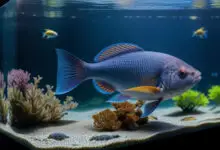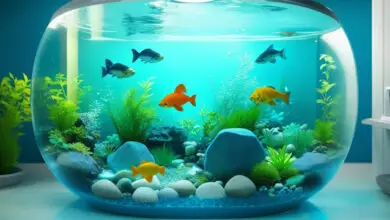Stopping Out-of-Control Algae Growth in Your Aquarium

Opening your aquarium cabinet to a green soupy mess is every fishkeeper’s nightmare. Aggressive algae blooms can rapidly take over a tank, covering surfaces in thick green fuzz and choking out plants. While some algae growth is normal, uncontrolled spreading can quickly ruin tank aesthetics and health.
The good news is with the right strategies, getting excessive algae under control is very doable. In this blog post, we will cover common aquarium algae types, what triggers mass blooms, and most importantly – how to safely eliminate unwanted green invaders for good. Soon your tank will be back to a pristine algae-free sanctuary for your fish.
What Causes Aggressive Algae Growth in Aquariums?
Before battling algae, it helps to know what underlying conditions enable it to thrive. The main factors that combine to trigger aggressive blooms include:
Excess Nutrients – Nitrates, phosphates, iron and CO2 that are not utilized by plants and instead feed algae spread. Overfeeding fish and using tap water with nutrients adds to this.
Intense Light – Too much bright light fuels rapid algae photosynthesis. Both intensity and duration of light exposure impacts growth rates.
Poor Water Quality – Issues like high nitrates, ammonia spikes, and fluctuating pH promote blooms by stressing livestock which then release more dissolving organic compounds for algae to feed on.
When these growth accelerators get too far out of balance, many forms of nuisance algae can gain a foothold and spread. Identifying and adjusting the source factors allows better control.
Common Aquarium Algae Types and Remedies
Many organisms get grouped under the term “algae”, but subtle differences change best removal methods for each. Here are the most common varieties found in home aquariums and proven ways to combat them:
Green Algae
This bright green slimy film quickly coats glass, decor, substrate and plants, blocking light needed for healthy tank life and photosynthesis.
Treatment: Manually remove what you can and do regular scrubbing. Cut light duration, target excess nutrients, add algae eaters.
Black Beard Algae
Stubborn black tufts that affix firmly to surfaces like plants, rocks and driftwood – often in shaded areas. Harbors toxins harmful for livestock.
Treatment: Remove manually, spray affected decor with hydrogen peroxide or Excel liquid carbon supplement. Prune shaded areas for better light penetration and water flow.
Brown Algae
A diatom originating from silicates that forms light to dark brown sheets on tank surfaces which are sticky or scratchy feeling. Easily wipes off but keeps rapidly returning.
Treatment: Silicate absorbing filter media helps remove its food source. Manually wipe down and vacuum as needed while maturing tank cycles and stabilizes. Will decline over time.
Blue-Green Algae
A type of bacteria that when bloomed looks like thick blue-green slime. Gives off strong unpleasant odor. Can be toxic with prolonged direct contact.
Treatment: Blackout tank for 3 days, then do a major water change while manually removing all you can find. Clean filter media thoroughly. Reduce organics and nitrates in water.
Hair Algae
This appropriately named algae has light green strands that can form mats up to several inches thick. Entangling plants prevents proper photosynthesis.
Treatment: Remove new growth manually before strands break apart and re-root elsewhere. Reduce light duration, deploy algicidal chemicals or antibiotic treatment if severe. Introduce algae eating fish.
Step-by-Step Game Plan for Eliminating Algae
Now we will outline a complete step-by-step strategy combining both remedial and preventative tactics to successfully beat back excessive algae while stopping it from returning again in full force.
| Task | Method | Reason |
|---|---|---|
| 1. Scrub All Surfaces | Manually wipe and brush away as much algae as possible from decor, glass and plants | Removes most algae so there is less to photosynthesize and reproduce |
| 2. Clean Filter & All Parts | Rinse cartridges and media in old tank water to preserve beneficial bacteria | Gets rid of trapped organics that feed algae before returning clean water |
| 3. Large Water Change | Replace 50% or more tank water | Greatly reduces concentrations of nutrients, organics and toxins |
| 4. Add Algae-Eating Crew | Employ Snails, Shrimp and Fish like Plecos | Clean-up crew will polish remaining algae away and nibble re-growth |
| 5. Install UV Sterilizer | Use for 1 week during worst phase | Neutralizes free-floating algae spores so they cannot reproduce |
| 6. Adjust Light Duration | Set to only 6-7 hours maximum | Limits key energy source driving photosynthesis during bloom |
| 7. Add Live Plants | Fast-growing stem plants, floating plants | Outcompete algae for nutrients and CO2 while oxygenating water |
| 8. Use Algicides If Needed | Peroxide, antibiotics, Excel liquid carbon | Chemicals that target remaining stubborn brown algae varieties |
| 9. Maintain Stability | Consistent feeding, light cycles & parameters | Prevent triggers like fluctuating pH, nutrients and dissolved organics |
If you execute this wall-to-wall reset, most types of rampant algae can be almost fully eliminated in just 1-2 weeks. Continue monitoring conditions post-treatment and use algae crew members plus live plants to prevent it from accumulating unchecked again long-term.
Choosing Safe & Effective Algae Control Crews
As seen in the battle plan, certain algae-eating fish, inverts and snails are powerful tools for entirely eradicating blooms and keeping them away for good. The key is selecting active varieties suitable for your aquarium type.
Here are top algae control crews:
For Small Aquariums:
- Red Cherry Shrimp – Roam plants nibbling most algae types. Peaceful for community tanks.
- Nerite Snails – Lean powerhouse snails with flat shells that don’t harm plants while efficiently clearing green spot and hair algae from leaves to glass.
- Otocinclus Catfish – The quintessential “algae eater” for freshwater planted tanks. Group of 6+ suggested. Gentle with compatible parameters.
For Large/Aggressive Tanks:
- Siamese Algae Eater – Very active fish that need space to constantly graze slimy green algae from all surfaces. Not compatible with all community tanks when mature due to aggressive tendencies.
- Florida Flagfish – Voracious appetite for hair algae. Withstands wide water parameter range. Semi-aggressive. Groups of 5+ work best.
- Chinese Algae Eater – Tough species that can hold its own. Removes thicker difficult beard/brush algae. High bioload produces much waste requiring extra filtration capacity.
For Saltwater Tanks:
- Scarlet Reef Hermit Crab – As they crawl over live rock, they pick off green algae, cyanobacteria and detritus. Helpful for sensitive reef tanks.
- Turbo Snail/Turban Snail – Targets hair, cyanobacteria and nuisance saltwater algae. Peaceful grazing snails safe for coral and anemones.
A clean-up crew customized to your tank specs will work non-stop to declutter irritating algae while helping prevent repeat outbreaks. This lets you get back to enjoying your aquarium rather than battling green nightmares.
Create an Algae-Resistant Aquarium
Aggressive algae management is fighting an uphill battle if underlying tank conditions continue fueling explosive growth. A better long-term approach emphasizes creating an aquarium environment fundamentally resistant to attacks from nuisance algae varieties in the first place through balance.
Follow this checklist to build an algae-proof tank:
🔹 Match intense lighting needed for coral/plants with ample CO2 injection
🔹 Only provide level of nutrients and fertilizer actually utilized rather than excess
🔹Introduce above clean-up crews once tank matures
🔹 Quarantine new plants/fish before adding to check for hitchhiker algae spores
🔹 Manually remove new algae strands quickly before they spread
🔹 Test source tap water – use RO/DI filters to remove phosphates/silicates if needed
By tailoring lighting, ferts, plant stocking and nutrient export to find balance, tanks can thrive while denying algae the unlimited food it wants to take over. Regular algae scrubbing becomes a thing of the past.
Enjoy Your Algae-Free Aquascape!
Once an aggressive algae bloom gets rolling, it can seem like a hopeless battle trying to clean every surface faster than it returns. But by using the step-by-step battle plan combining physical removal, chemical treatments, clean-up crews and tank balancing strategies – you can eliminate even heavy infestations for good in 1-2 weeks.
Consistent monitoring and maintenance focused on stability and balance is key to prevent it from rebounding once under control. When all systems are properly calibrated to limit algae’s growth fuels, your tank transitions to a lush underwater oasis able to better resist future attacks should an imbalance arise again down the road.
With vibrant plant growth, sparkling water clarity and of course happy fish that get to view it all – having a tank that looks as pristine as it functions makes aquarium ownership a true joy!







